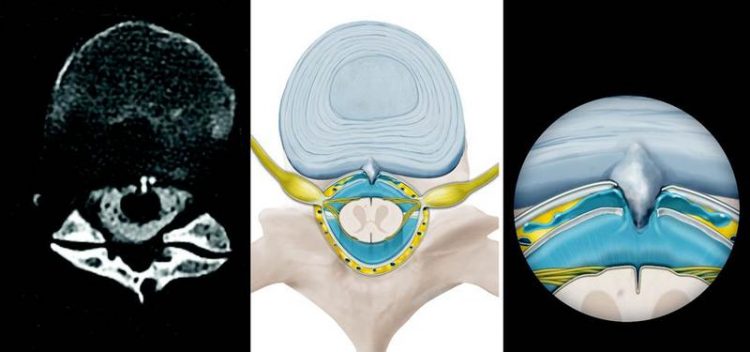When the Brain is High and Dry

A calcified microspur cuts open the nervous tissue cover (dura) like a sharp knife. Cerebrospinal fluid then leaks when standing up and those affected suffer the worst headaches. Department of Neurosurgery, Inselspital, Bern University Hospital
Fluid protects our brains and spinal cords. If it is lost and can no longer be reproduced, the brain is literally high and dry. Those affected will then suffer from severe headaches that are only relieved by lying down. Affected patients can develop nausea, stiffness in the neck, spells of dizziness, inability to work and dangerous bleeding. This condition frequently occurs spontaneously and with no apparent cause.
Tiny Spurs Damage the Nervous Tissue Cover
Using the latest imaging processes and microsurgery, neurosurgeons, neuroradiologists and neurologists at the University Neurocenter in Bern have found tiny, calcified extensions of intervertebral discs on the spines of people affected. These spurs bore holes in the nervous tissue cover (dura) that protects the cerebrospinal fluid.
The resulting leak was found in most patients in the thoracic spine or the lower cervical spine. In a study, the doctors examined 14 of 69 patients with particularly persistent cases of the illness using microneurosurgery. In all patients operated on, the spur could be removed immediatelty after diagnosis and the leak could be stopped.
Diagnosis and Cure in One Operation
Study director Jürgen Beck describes the discovery as a turning point for the patients: “The illness is often severe and severely debilitating. Now we have been able to show how the leaks occur within the system and at the same time provide a solution. This is attracting patients from all over the world.“
The success rate of the new operation method speaks for itself: The neurosurgeons in Bern were able to cure 93 per cent of patients with microspurs. As a result, they are already receiving one third of their referrals from abroad. Beck dedicates one day a week just to patients suffering from intracranial hypotension. In spring 2016, he convened the first international congress on the topic in Oberhofen. Today, his study appears as a “landmark article“ on the front cover of specialist journal Neurology.
Contact:
Prof. Dr. med. Jürgen Beck, Physician-in-Chief, Department of Neurosurgery, Bern University Hospital, +41 79 457 22 42, Juergen.Beck@insel.ch.
http://www.neurology.org/content/early/2016/08/26/WNL.0000000000003122
Media Contact
More Information:
http://www.insel.chAll latest news from the category: Health and Medicine
This subject area encompasses research and studies in the field of human medicine.
Among the wide-ranging list of topics covered here are anesthesiology, anatomy, surgery, human genetics, hygiene and environmental medicine, internal medicine, neurology, pharmacology, physiology, urology and dental medicine.
Newest articles

NASA: Mystery of life’s handedness deepens
The mystery of why life uses molecules with specific orientations has deepened with a NASA-funded discovery that RNA — a key molecule thought to have potentially held the instructions for…

What are the effects of historic lithium mining on water quality?
Study reveals low levels of common contaminants but high levels of other elements in waters associated with an abandoned lithium mine. Lithium ore and mining waste from a historic lithium…

Quantum-inspired design boosts efficiency of heat-to-electricity conversion
Rice engineers take unconventional route to improving thermophotovoltaic systems. Researchers at Rice University have found a new way to improve a key element of thermophotovoltaic (TPV) systems, which convert heat…



